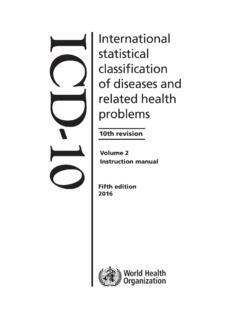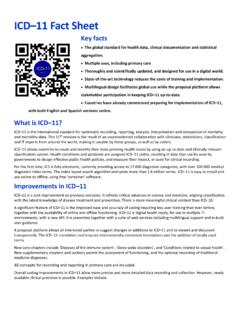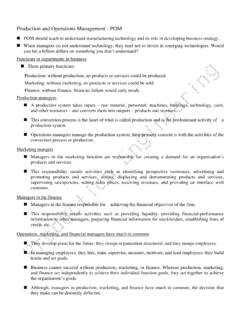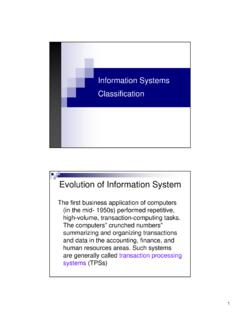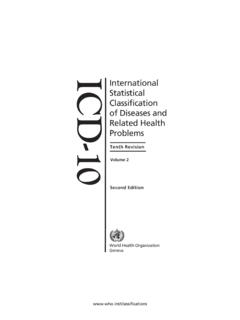Transcription of ICD-11 Implementation or Transition Guide
1 ICD-11 Implementation or Transition Guide Implementation or Transition Guide World Health Organization 2019 Some rights reserved. This work is available under the Creative Commons Attribution-NonCommercial-ShareAlike IGO license (CC BY-NC -SA IGO ). Under the terms of this license, you may copy, redistribute the work for non-commercial purposes, provided the work is appropriately cited, as indicated below. In any use of this work, there should be no suggestion that WHO endorses any specific organization, products or services. The use of the WHO logo is not permitted. You are not allowed to adapt the work. If you create a translation of this work, you should add the following disclaimer along with the suggested citation: This translation was not created by the World Health Organization (WHO). WHO is not responsible for the content or accuracy of this translation. The original English edition shall be the binding and authentic edition.
2 Any mediation relating to disputes arising under the license shall be conducted in accordance with the mediation rules of the World Intellectual Property Suggested citation. ICD-11 Implementation or Transition Guide , Geneva: World Health Organization; 2019; License: CC BY-NC-SA IGO. Third-party materials. If you wish to reuse material from this work that is attributed to a third party, such as tables, figures or images, it is your responsibility to determine whether permission is needed for that reuse and to obtain permission from the copyright holder. The risk of claims resulting from infringement of any third-party-owned component in the work rests solely with the user. General disclaimers. The designations employed and the presentation of the material in this publication do not imply the expression of any opinion whatsoever on the part of WHO concerning the legal status of any country, territory, city or area or of its authorities, or concerning the delimitation of its frontiers or boundaries.
3 Dotted and dashed lines on maps represent approximate border lines for which there may not yet be full agreement. The mention of specific companies or of certain manufacturers products does not imply that they are endorsed or recommended by WHO in preference to others of a similar nature that are not mentioned. Errors and omissions excepted, the names of proprietary products are distinguished by initial capital letters. All reasonable precautions have been taken by WHO to verify the information contained in this publication. However, the published material is being distributed without warranty of any kind, either expressed or implied. The responsibility for the interpretation and use of the material lies with the reader. In no event shall WHO be liable for damages arising from its use. " 2 About this document version This document is a part of the ICD11 Implementation package developed by the World 1 Health Organization.
4 This document also provides some background related to the development of the ICD11 and its components. The document outlines essential issues that countries need to consider in the lead up to and during the Transition from an existing ICD environment to the eventual Implementation of ICD11. Because of the vast differences and varying complexities in the local settings, and between area to area, this Guide can provide only an overview of Transition and Implementation . This Guide supports decisionmakers in planning the Implementation of the new ICD11 in their jurisdictions. All elements of ICD11 are available on and readers are encouraged to take a virtual tour, and gain hands-on experience. The document has two parts, where Part 1 provides an overview and background to the 11th Revision, while Part 2 is concerned with transitional activities.
5 Acknowledgements The production of this Guide would not have been possible without the collaboration and support of numerous organizations, institutions and individuals. It is based on requirements from the field and has been compiled in collaboration between all WHO Regional Offices, Headquarters, the WHOFIC Network, and Member States. 23 The ICD-11 implementa=on package comprises the Classifica=on System, the Coding Tool, Browser and all suppor=ng documents 1including the Reference Guide and Implementa=on Guide , and a set of tools Argen=na; Australia; Bangladesh; Bhutan; Canada; Chile; China; Colombia; Costa Rica; Cuba; Czech Republic; Denmark; Dominican 3 Republic; Ecuador; Estonia; Fiji; France; Georgia; Germany; Ghana; Guatemala; Honduras; India; Indonesia; Italy; Japan; Cambodia; Kazakhstan ; Kenya; Korea; Kyrgyzstan; Laos; Liberia; Malaysia; Mexico; Mongolia; Myanmar; Namibia; Nepal; Netherlands; Nicaragua; Nigeria; Norway; Panama; Paraguay; Peru; Philippines; Poland; Portugal; Russia; Rwanda; Senegal; Solomon; South Africa; Sri Lanka; Sweden; Tanzania; Thailand; Timor-Leste; Turkey; Turkmenistan; Uganda; United Kingdom; Uruguay; USA; Venezuela; Vietnam; Zambia" IIIICD11 in a Nutshell 1.
6 General Background to ICD 2 .. to ICD 3 .. ICD11 5 .. revised classification system 5 .. digital format 5 .. of ICD11 6 .. scientific knowledge 6 .. and additions 6 .. of use 7 .. applications to meet health system priorities 7 .. ICD11 package and components 8 .. health (eHealth) compatibility and interoperability with Health Information Systems 9 .. with other classifications and terminologies 10 .. of ICD 11 .. or transitioning from existing systems of ICD 13 .. considerations for ICD11 13 .. coding 13 .. coding 14 .. to early-adopters and pilot testing 15 .. involvement and agreement 15 .. recommended actions 15 .. a National Centre of Excellence 15 .. of existing system during the Transition 16 .. management and strategic planning 16 .. 17 .. (mapping) and comparability 20 .. Coding Studies 21 .. of ICD11 with terminologies and electronic health records 21 .. requirements and lead time for health information system changes mortality and morbidity coding tools and casemix groupers 22.
7 23 .. - Template timetable for Implementation 23 .." - Content of Implementation Package 26 .. - Overview of Development of the ICD11 27 .. - Glossary of Terms " V" VIICD11 in a Nutshell The International Classification of Diseases and Related Health Problems (ICD) is the international standard for systematic recording, reporting, analysis, interpretation and comparison of mortality and morbidity data. The 11th revision (ICD11) is the result of a collaboration with clinicians, statisticians, epidemiologists, coders, classification and IT experts from around the world. ICD-11 is a scientifically rigorous product which accurately reflects contemporary health and medical practice, and representing a significant upgrade from earlier Revisions. ICD 11 allows countries to count and identify their health issues by using a current and clinically relevant classification system.
8 Health conditions or accidents are assigned ICD 11 codes, resulting in data that can be used by governments to design effective public health policies, and measure their impact, allocate resources, improve treatment, improve prevention, or be used for clinical recording. For the first time, ICD is fully electronic, currently providing access to 17 000 diagnostic categories, with over 100 000 medical diagnostic index terms. The index-based search algorithm interprets more than million terms. ICD 11 is easy to install and use online or offline, using free 'container' software. ICD11 is easier to use than ever before, cost of coding is low, and data capture is more accurate for best quality output, thanks to the use of modern technology. The innovative structure and digital format ensure interoperability with existing IT infrastructure. ICD11 covers a broad range of uses including, clinical recording, the collection and study of mortality and morbidity statistics, epidemiological research, casemix studies, quality and safety interventions and planning, primary care and more.
9 It offers more than disease diagnoses for statistical purposes it also allows for the coding of signs, findings, causes of injury and harm, rare diseases, medical devices, medicaments, anatomy, severity scales, histopathology, work or sports activities, and and much more. It links clinical terminology with statistics. ICD11 is now available for Implementation , following its adoption at the World Health Assembly on 25 May 2019. The Reference Guide provides fully detailed comprehensive information on ICD11, its maintenance, significant changes and differences between ICD10 and ICD11.. 4 ICD11 and its Implementation package are available freely online and can be used as is. No additional tools or terminologies are necessary. " 1 General Background to ICD The ICD provides a common language for the classification of diseases, injuries and causes of death, and for the standardised reporting and monitoring of health conditions.
10 It is designed to map health conditions to corresponding generic categories together with specific variations, assigning to these a designated code, up to six characters long. These data form the basis of comparison and sharing between health providers, regions and countries, and over periods. In addition to this essential core function, the ICD can also inform a wide range of related activities. It is used for health insurance reimbursement; in national health programme management; by data collection specialists and researchers; for tracking progress in global health; and to determine the allocation of health resources. Patient quality and safety documentation is also heavily informed by the ICD. Revised cyclically by WHO, the ICD is presented to the World Health Assembly for adoption and Implementation into national data collection and reporting systems.
